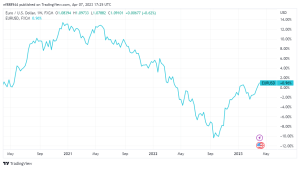On Friday, the EURUSD pair is trading at 1.0910, up for the third week in a row. Banking concerns were set aside by financial markets due to a lack of new news on the subject. Which was already dormant in the background. Instead, the focus is on economic growth and, once again. Whether central banks have gone too far with monetary tightening or whether there is still capacity to compress it a little further.
There have been no substantial policy pronouncements, but macroeconomic data has raised some concerns as the global economic downturn continues. The March S&P Global Manufacturing PMIs were confirmed to be below 50. The line that distinguishes growth from contraction. European numbers were revised upward, with the German index remaining at the Eurozone figure was revised down to 44.7. While the US figure was revised down to 49.2. At the same time, the Services PMIs in the EU and the US remained in growth zone but were revised downward.
The United States’ terrible macroeconomic numbers have reignited recessionary fears.
Investors were dismayed by macroeconomic data from the United States. Which showed the country was going into a recession. The official ISM PMIs fell in March compared to February, and the results were worse than expected.
Worse, employment data revealed that the labor sector has begun to relax. Which may be good news for the US Federal Reserve (Fed), since it indicates less inflationary pressure from that side. At the same time, it increases the likelihood of an economic downturn. While failing to change the existing central banks’ dovish approach.
JOLTS For the first time in almost two years, the number of job opportunities dipped below 10 million in February, as the number of job postings plummeted in most industries. Furthermore, according to the ADP poll, the private sector added just 145K new positions in March, falling short of estimates. Finally, the March Nonfarm Payrolls data showed a headline of 236K, which was somewhat lower than the 240K projected. However, the participation rate rose to 62.6%, while the unemployment rate remained unchanged. The rate fell by 3.5%, indicating that the market is easing more. Wage growth was lower than predicted, indicating that inflationary pressures are lessening.
EURUSD Technical Analysis
The weekly chart of the EURUSD pair reveals that it is still positive, albeit the bullish potential has diminished. The Momentum indicator remains flat, barely over the 100 level, but the Relative Strength Index (RSI) indicator continues to rise near overbought levels. Simultaneously, a bearish 100 Simple Moving Average (SMA) stops the upside at the mentioned weekly high, while a solidly bullish 20 SMA leads the way upward by moving strongly up much below the present level.

On the daily chart, the technical picture is similar. The EURUSD is trading well above bullish moving averages, with the 20 SMA providing dynamic support at 1.0800.
Technical indicators, on the other hand, fall off new multi-week highs reached mid-week, although with limited downward strength and volatility. considerably above their midlines.
The EURUSD pair is presently facing resistance at 1.1000, with advances above it initially exposing the 1.1060 level route to the 1.1120/40 price zone. Below 1.0800, the pair might continue to fall towards 1.0745, the 61.8% retracement of the 2022 annual loss.









